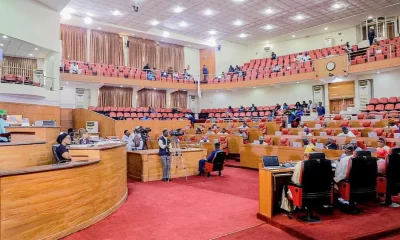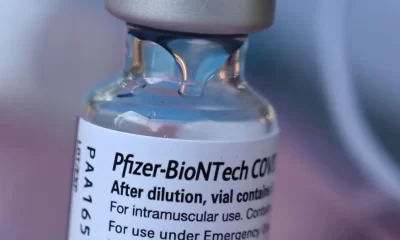Health
Skyrocketing IVF costs push fertility treatments out of reach for many Nigerians
Published
1 year agoon

The cost of a single in vitro fertilization (IVF) cycle in Nigeria has soared to approximately N2.1 million ($2,730), reflecting a staggering 250% increase since 2019 when prices ranged between N600,000 and N1.2 million.
This price hike has made IVF treatments far less accessible, especially for middle-income families, as the average annual income in Nigeria hovers around N2 million ($2,600).
For many, the cost of a single IVF cycle now exceeds a year’s salary, with multiple cycles often required for a successful pregnancy.
Dr. Kemi Ailoje, a reproductive endocrinologist and CEO of Lifelink Fertility, highlights the growing acceptance of assisted reproductive technologies among couples facing infertility.
She notes that while awareness has increased in urban areas, efforts to reach rural communities remain insufficient. “There is still much work to be done in terms of access and information,” Ailoje emphasized.
According to various fertility clinics in Nigeria, two IVF cycles can cost up to N3.8 million ($4,940), while three cycles may reach N5.6 million ($7,250).
READ ALSO: Cost of IVF in Nigeria
Some clinics charge as high as N5.5 million for two fresh treatment cycles and up to N7.6 million for three cycles, significantly adding to the financial burden for couples seeking fertility treatments.
At a recent conference hosted by the Association of Fertility and Reproductive Health of Nigeria, it was revealed that the number of IVF clinics in the country has increased to around 180, a notable rise from previous years.
However, the sharp increase in costs means that many couples are now left with limited options.
In comparison, IVF pricing in Nigeria presents an intriguing contrast to global trends. In the United States, the average cost per cycle ranges between $14,000 and $20,000 (N20 million to N33.3 million), while the UK offers treatments between £5,000 and £8,000 (N4.6 million to N7.4 million).
Other countries like Turkey offer IVF for as low as €1,700, with Denmark and Spain pricing treatments between €3,500 and €4,000.
Globally, the IVF market is projected to grow from $27 billion in 2022 to $37.4 billion by 2030, reflecting a compound annual growth rate (CAGR) of 5.54%.
This expansion is driven by an increasing demand for fertility treatments as birth rates continue to decline worldwide.
READ ALSO: This lifestyle can affect quality of man’s sperm – Expert
Prof. Oladapo Ashiru, founder of the Medical Art Center and Secretary General of the International Federation of Fertility Societies, underscored the severity of the situation.
“Globally, one in six people face fertility challenges, but in Nigeria, it’s even worse—one in four,” Ashiru remarked, highlighting the lack of affordable access to necessary care. Around 35% of couples trying to conceive may require some form of assisted reproductive technology, according to Ashiru.
Despite the prohibitive costs, Nigeria has become a destination for international patients due to favorable exchange rates.
“People are coming from Europe, America, and neighboring West African countries because, despite the high cost, they still find it cheaper here,” Ashiru explained.
However, the cost of medication alone has seen drastic increases, with prices multiplying by four since the beginning of 2024. “At this point, IVF ranges from N4 million to N5 million, depending on the complexity of the case,” Ashiru added.
For Nigerians, IVF offers critical solutions for blocked fallopian tubes, ovulation disorders, low sperm count, and other reproductive health challenges.
Nevertheless, most health insurance plans in Nigeria do not cover fertility treatments, leaving couples to bear the financial burden out of pocket. Government policies remain focused on maternal and child health, with limited attention to infertility services.
Couples like Nkechi and Emmanuel, both in their late 30s, are feeling the impact. “After several failed attempts to conceive naturally, our doctor recommended IVF.
But when we saw the cost—ranging from N4 million to N5 million—we were overwhelmed,” Nkechi shared.
Similarly, Josephine and her husband faced secondary infertility following multiple miscarriages.
“Although I had a child years ago, getting pregnant again became impossible. We were hesitant to try IVF because of the social stigma and high cost, but we knew it was our only hope,” she said.
READ ALSO: 70-year-old Ugandan woman gives birth to twins, becomes Africa’s oldest
Dr. Ailoje attributes the rising infertility rates in Nigeria to a mix of economic, social, and environmental factors. “Poorly managed sexually transmitted diseases (STDs), delays in starting families due to career pursuits, and the rising age of marriage are all contributing to lower fertility rates,” she noted.
Additionally, environmental pollutants and toxins, combined with occupational hazards, are increasingly being recognized as significant concerns.
The broader implications of Nigeria’s declining fertility rates, combined with the high cost of fertility treatments, are far-reaching.
With the average number of children per family declining since the 1950s, the country may face serious population replacement issues by 2050 if current trends continue.
Trending

 Football7 days ago
Football7 days agoAFCON 2025 shock: CAF sacks referee hours before Algeria–Nigeria quarterfinal

 Comments and Issues1 week ago
Comments and Issues1 week agoAnthony Joshua: A wake-up call on road safety

 Comments and Issues1 week ago
Comments and Issues1 week agoOsimhen vs Lookman feud

 Latest1 week ago
Latest1 week agoImpeachment drama in Rivers puts Wike, Tinubu administration under spotlight

 News5 days ago
News5 days agoLagos passes ₦4.44t as Y2026 budget

 Business1 week ago
Business1 week agoKPMG flags gaps in new Tax Act, warns of disputes, investment loss, capital flight

 Health1 week ago
Health1 week agoBayer sues Pfizer, Moderna over alleged use of Monsanto GMO Tech in COVID vaccines

 Latest6 days ago
Latest6 days agoBaba-Ahmed: Obi has not defected to ADC

